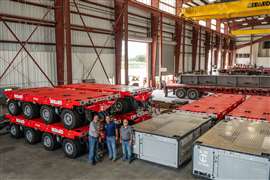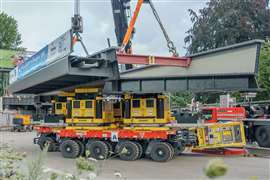Arresting a fall
30 April 2008
Occupational Safety and Health (OSHA) and Mine Safety and Health Administration (MSHA) standards require that, in work areas where other fall protection systems cannot be used or have been removed, workers must use fall arrest systems.
Federal, state and local guidelines should always be checked to be sure your program meets the applicable requirements. Unless unfeasible, 100% fall protection is best practice. It is best to conduct a fall protection hazard assessment to evaluate recognized fall hazards, the method of fall protection you may consider, and the procedures for assembly, inspection, maintenance and disassembly of the system. You may want to develop a company fall prevention safety checklist or a fall protection pre–job planning checklist.
A personal fall arrest system is necessary when working on open–sided floors, elevated work platforms, and on roofs and during crane assembly and crane maintenance.
The three key elements of a personal fall arrest system are the anchorage, the connector and the harness.
The anchorage is the securement point of attachment for life lines, lanyards and other deceleration devices. The anchorage point must be capable of supporting at least 5,000 pound per user or shall be designated, installed and used under the supervision of a Qualified Person as part of a complete system that maintains a safety factor of at least two.
The connector is a device used to couple or connect parts of a fall protection system together. It is an integral part of the system, for example, a D–ring or buckle sewn into the full body harness. A snap hook spliced or sewn into a self–retracting lanyard or other type of lanyard is also a connector. A lanyard is used as a connector. The lanyard connects a full–body harness and, at the other end, an anchorage point, deceleration device or lifeline for fall arrest.
The body harness is a design of straps that is used to secure the torso and thighs. In the event of a fall the arresting forces are distributed over the torso and thighs. The fall arrest attachment point of the harness shall be at the center of the user's back near shoulder level. The harness should be removed from service upon evidence of defects, damage, deterioration, or if it has been subjected to impact loading, or upon expiration of the manufacturer's specified service limits, whichever comes first.
Your fall arrest system must be visually inspected before you use the equipment and periodically during your work task. Check equipment for deterioration, frayed edges, broken fibers, pulled stitches, burns, and chemical and ultraviolet damage. Damaged fall arrest equipment must be removed from service.
Be sure your harness fits properly, always connect the leg straps, and tighten all straps before using it. The D–ring of the harness must be in the middle of your back. A lanyard or self–retracting lanyard must be attached by a locking snap hook to the D–ring of the harness. Never attach a lanyard to a self–retracting device. A lanyard should not be connected back to itself unless authorized by the manufacturer. Never knot a lanyard, tie two together or tieoff around sharp edges. Shock absorbing lanyards are best; they are made of rope, nylon, or steel. Your anchorage point should be directly above you; make sure that if you fall you will not swing and that the fall distance does not exceed six feet. Always consider the lanyard, the soft pack and stretching distance of all components.
Be sure to have a rescue plan to retrieve workers who may fall. Immediate rescue is very important. A worker suspended in a harness may become unconscious, immobile and the level of venous pooling could result in orthostatic intolerance and possible death.
STAY CONNECTED


Receive the information you need when you need it through our world-leading magazines, newsletters and daily briefings.
CONNECT WITH THE TEAM











